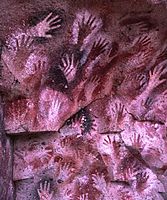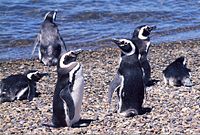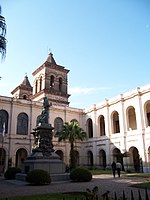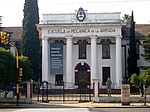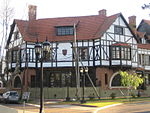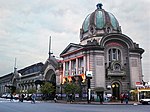World Heritage in Argentina
The world heritage in Argentina includes (as of 2017) eleven UNESCO world heritage sites , including six world cultural heritage sites and five world natural heritage sites. Argentina acceded to the World Heritage Convention in 1978, and the first World Heritage site was added to the World Heritage List in 1981. The last World Heritage site to date was registered in 2017.
World heritage sites
The following table lists the UNESCO World Heritage Sites in Argentina in chronological order according to the year of their inclusion on the World Heritage List (K - cultural heritage, N - natural heritage, K / N - mixed, (R) - on the Red List of World Heritage in Danger ).
![]() Map with all coordinates of the World Heritage Sites: OSM
Map with all coordinates of the World Heritage Sites: OSM
| image | designation | year | Type | Ref. | description |
|---|---|---|---|---|---|
|
Los Glaciares National Park ( location ) |
1981 | N | 145 | The national park essentially consists of the three large glaciers Perito Moreno Glacier , Upsala Glacier and Viedma Glacier . Los Glaciares National Park encompasses an Area of Outstanding Natural Beauty, with rugged, towering mountains and numerous glacial lakes. It also includes the Patagonian ice field, which takes up about half of the park. | |
| Jesuit missions of the Guaraní: San Ignacio Mini, Santa Ana, Nuestra Señora de Loreto, Santa Maria Mayor, ruins of Sao Miguel das Missoes | 1984 | K | 275 | The Jesuit reductions of the Guaraní are a transnational world heritage of Argentina and Brazil. At the World Heritage Sites is the Jesuits created settlements for the people of the Guaraní : San Ignacio Mini , Nuestra Señora de Santa Ana , Nuestra Señora de Loreto and Santa Maria la Mayor in Argentina as well as the ruins of São Miguel das Missões in Brazil. The aim of these settlements was primarily the Christian missionary work of the Guarani. The ruins of São Miguel das Missões, in Brazil, were declared a World Heritage Site in 1983, and this World Heritage site was then supplemented by the Argentine sites in 1984. | |
|
Iguazú National Park ( location ) |
1984 | N | 303 | The national park includes the Iguazú waterfalls with a height of about 80 m, which are considered the most spectacular waterfalls in the world. | |
|
Cueva de las Manos (cave paintings), Rio Pinturas ( location ) |
1999 | K | 936 | The Cueva de las Manos ( Spanish for "Cave of Hands") is a cave, which got its name from the fact that a large part of the cave paintings consists of hand negatives . | |
|
Peninsula Valdés ( location ) |
1999 | N | 937 | The Valdés Peninsula in Patagonia is an area of outstanding global importance for the conservation of various species of marine mammals such as southern capers , killer whales or southern elephant seals . | |
|
Ischigualasto and Talampaya nature parks ( location ) |
2000 | N | 966 | The two adjoining parks Ischigualasto and Talampaya contain a wide range of fossils of mammals, dinosaurs and plants from the Triassic in their six geological formations. | |
|
Jesuit Block and Estanzias of Cordoba ( location ) |
2000 | K | 995 | The city block and the five rural farms and manufacturing facilities in the province of Córdoba are an example of the territorial organization, the economic links between urban and rural settlements, with which the Jesuits pursue their educational and missionary goals. | |
|
Quebrada de Humahuaca ( location ) |
2003 | K | 1116 | The Quebrada de Humahuaca is a gorge near the capital of the Argentine province of Jujuy. It is a representative example of the southern Andean valleys, with their system of traffic routes and economic, social and cultural connections. | |
|
Qhapaq Ñan - Andean Road System ( location ) |
2014 | K | 1459 | The main Andean road, Qhapaq Ñan, was part of the Inca road system in South America. It was the main connection in the north-south direction and extended over 6,000 kilometers. (cross-border with Colombia, Ecuador, Peru, Chile and Bolivia, includes 13 individual sites in Argentina) | |
|
The architectural work of Le Corbusier - an outstanding contribution to the "modern movement" ( location ) |
2016 | K | 1321 | 17 buildings by the architect Le Corbusier were added to the list. With the Casa Curutchet in La Plata , one of the buildings is in Argentina, the rest in Switzerland , Belgium , France , Germany , India and Japan . The buildings show the solutions that modernity offered in the 20th century for the challenges of inventing new architectural techniques in order to meet the needs of society.
|
|
|
Los Alerces National Park ( location ) |
2017 | N | 1526 |
Tentative list
The sites that are intended for nomination for inclusion in the World Heritage List are entered in the tentative list .
Current World Heritage candidates
Currently (2019) eight sites are entered in the tentative list of Argentina, the last entry was in 2019. The following table lists the sites in chronological order according to the year of their inclusion in the tentative list.
![]() Map with all coordinates of current World Heritage candidates: OSM
Map with all coordinates of current World Heritage candidates: OSM
| image | designation | year | Type | Ref. | description |
|---|---|---|---|---|---|
| Valles Calchaquíes | 2001 | K | 1582 | Chain of connected valleys on the eastern slope of the Andes | |
|
Sierra de las Quijadas National Park ( location ) |
2005 | N | 2021 | known for fossils and dinosaur tracks from the Aptium from around 120 million years ago and for its bizarre rock formations. | |
| La Payunia, Campos Volcánicos Llancanelo y Payún Matrú | 2011 | N | 5615 | ||
| Geological, paleontological and archaeological provincial reserve Pehuen-Có - Monte Hermoso | 2014 | K / N | 5851 | ||
| Moisés Ville | 2015 | K | 6066 | Jewish colony | |
|
ESMA Museum - Former Secret Center for Imprisonment, Torture and Execution ( Location ) |
2017 | K | 6248 | Place of terror of the Argentine military dictatorship . | |
| The city of Tigre and its rowing clubs | 2017 | K | 6288 | The city of Tigre , about 30 km northwest of Buenos Aires , is characterized by the rivers and streams that surround it. The rowing clubs founded by immigrants in the late 19th and early 20th century are a testament to the cosmopolitan spirit that shaped Argentina at that time. | |
| Buenos Aires - La Plata: Two main cultural centers of modernity, eclecticism and immigration | 2018 | K | 6296 | Extensive architectural ensembles of modernism and eclecticism , which emerged during the immigration wave at the end of the 19th and early 20th century, shape the cities of Buenos Aires and La Plata to this day . | |
| Cueva de las Manos and related sites in the basin of the Río Pinturas | 2018 | K | 6297 | The proposal includes other significant archaeological sites in the canyon and the catchment area of the Río Pinturas , which complement the findings in the Cueva de las Manos ( Ref. 936 ), which is already recognized as a cultural heritage . | |
| The Sanmartinian Routes | 2019 | K | 6384 |
Former World Heritage candidates
These sites were previously on the tentative list, but were withdrawn or rejected by UNESCO. Sites that are included in other entries on the tentative list or that are part of world heritage sites are not taken into account here.
![]() Map with all coordinates of former World Heritage candidates: OSM
Map with all coordinates of former World Heritage candidates: OSM
| image | designation | year | Type | Ref. | description |
|---|---|---|---|---|---|
| Cerro Colorado | 1987-1987 | K | |||
| Reserva faunística provincial Cabo Dos Bahías | 1995-2003 | N | Reserva Natural Turistica de Objetivo Integral | ||
|
La Plata, urban start-up zone ( location ) |
1998-2012 | K | 1085 | Withdrawn from Argentina | |
| Las Parinas | 2001–2012 | K / N | 1584 | Withdrawn from Argentina | |
|
City of Buenos Aires: cultural landscape ( location ) |
2005–2012 | K | 2022 | Not considered unique enough by ICOMOS 2008. |
Web links
- Argentina on the UNESCO World Heritage Center website.
Individual evidence
- ↑ Argentina. In: whc.unesco.org. UNESCO World Heritage Center, accessed July 10, 2017 .
- ^ Tentative list of Argentina. In: whc.unesco.org. UNESCO World Heritage Center, accessed May 1, 2019 .
- ^ Former Tentative Sites of Argentina. In: World Heritage Site. Retrieved July 10, 2017 (English).





